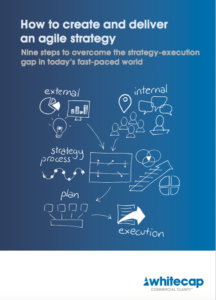 Pat Chapman-Pincher, a FTSE CEO mentor and non-executive director, has built, run, sold and chaired technology businesses for more than 30 years. She argues many boards don’t look ahead at new opportunities and risks when planning a strategy.
Pat Chapman-Pincher, a FTSE CEO mentor and non-executive director, has built, run, sold and chaired technology businesses for more than 30 years. She argues many boards don’t look ahead at new opportunities and risks when planning a strategy.
In Whitecap Consulting’s whitepaper, How to create and deliver an agile strategy, I posed five challenging questions for boards to understand how they can develop a successful strategy for the future. Here I share my thoughts on what boards should consider.
Probably one of the hardest challenges an executive team faces when developing a strategy is setting the degree of ambition. Not only do they have to consider the capacity and capabilities of their own business, but also understand enough about technologies and disruptive businesses to see where opportunities and risks could come from.
Twenty years ago it was almost impossible to imagine a business achieving world domination in a decade. Yet, taxi firm Uber was founded six years ago, Twitter is just nine years old and global giant Goole is only 17-years-old.
The reality is that technology has transformed the business landscape for every sector and most boards need to take a radically different approach to exploit this and minimise risks.
Look forward at business risk
The biggest problem we face is that we tend to look backwards, rather than forwards, at risk. When planning a strategy we focus on the things that have caused us problems in the past and plan to prevent them in the future.
This is why there is now so much regulation to prevent another financial crisis. In addition, we become very wary of anything that looks similar to problems that have happened in the past – hence, so much is still written about where the next financial crisis will come from.
What we rarely do is look for any risks that look different – the risks we may not yet understand. Businesses have short memories and the pain of 2008 is already becoming a hazy recollection. The result of that is that the risk management reins are being relaxed, with many leaders worrying it holds back growth and damages profitability.
Understanding strategic risk
I’d argue the banking crisis was not down to financial risk. Instead, it was more a crisis of management and therefore a strategic risk. Things were happening that the managers in the businesses either did not understand, did understand but chose to ignore, or were complicit.
The same thing can be said for the collapses of Enron, Worldcom and all of the other business scandals. The demise of companies is almost always down to strategic risk, rather than a few bad apples who gambled on the financial markets.
Kodak might still be alive today if the board had taken a broader view of risk and seen the threat that digital technology posed – so might a lot of banks, retailers, communication firms and more. The problem the Kodak board faced was simply that they did not know what they did not know.
Looking back, it all looks so obvious. When you are looking ahead it’s much less obvious and more comforting to worry about what happened in the past rather than in the future.
How can a board plan for the future?
So how can you mitigate risk by getting help with knowing what you cannot know? Planning a strategy is about taking an objective review of your performance, your aims and the external factors that could impact your business.
Think about bringing real diversity to the board – not just gender and ethnicity – but younger and more entrepreneurial people who understand technology and disruptive businesses. Ask what technologies could impact your business, which could transform your business and if you have the courage to tear your business apart to respond?
Ultimately, you have to carve out time in a busy board schedule to think and learn about the future and three things can help a board do this:
- Look at the board’s annual schedule of work (if you don’t have one then develop one fast). Analyse how much of that work is about preventing mistakes of the past and how much about the future of the company
- Most boards have an annual strategy day/half day. What normally happens is that the day is spent on next year’s plan and budget and not on strategy at all. Change what you do – really think about the future instead of the incremental work of the next 12 months
- Create a team of people within the company with a ‘licence to dream’ about the future – and listen to them.
Whitecap’s How to create and deliver an agile strategy has some great insights for developing a strategy and I’d love to hear if you have anything to add about how boards should plan for an uncertain future.
